Light
Light is a form of energy eyes. which produces the Sources of light are of three types-thermal sources and luminescent sources.
Photometry is a branch measurement of light energy.
Characteristics of Light
Light waves are electromagnetic waves, whose nature is transverse. The speed of light in vacuum is 3 x 108 mls but it is different in different media.
The speed and wavelength of light change when it travels from one medium to another but its frequency remains unchanged.
Important Terms
(i) Luminous Objects The objects which emits its own light, are called luminous objects, e.g., sun, other stars, an oil lamp etc.
(ii) Non-Luminous Objects The objects which do not emit its own light but become visible due to the reflection of light falling on them, are called non-luminous objects, e.g., moon, table, chair. trees etc.
(iii) Ray of Light A straight line drawn in the direction of propagation of light is called a ray of light.
(iv) Beam of Light A bundle of the adjacent light rays is called a beam of light.

(v) Image If light ray coming from an object meets or appear to meet at a point after reflection or refraction, then this point is called image of the object.
(vi) Real Image The image obtained by the real meeting of light rays, is called a real image.
Real image can be obtained on a screen. Real image is inverted.
(vii) Virtual Image The image obtained when light rays are not really meeting but appears to meet only, is called a virtual image.
Reflection of Light
The rebouncing back of light rays into the same medium on striking a highly polished surface such as a mirror, is called reflection of light.
Laws of Reflection
There are two laws of reflection.
(i) The incident ray, the reflected ray and the normal at the point of incidence all three lie in the same plane.
(ii) The angle of incidence (i) is always equal to the angle of reflection (r).
Types of Reflection

(i) Regular Reflection When a parallel beam of reflected light rays is obtained for a parallel beam of incident light rays after reflection from a plane reflecting reflection is called regular reflection.
(ii) Irregular or Diffused Reflection When a non-parallel beam of reflected light rays is obtained for a parallel beam of incident light rays after reflection from a surface, then such type of reflection is called irregular or diffused reflection.

Mirror
A smooth and highly polished reflecting surface is called a mirror.
(i) Plane Mirror A highly polished plane surface is called a plane mirror.
Different properties of image formed by plane mirror
Size of image = Size of object
Magnification == Unity
Distance of image == Distance of object
A plane mirror may form a virtual as well as real image.
A man may see his full image in a mirror of half height of man. When two plane mirror are held at an angle θ, the number of images of an object placed between them is given as below
(a) n = [(360° / θ) – 1 ], where 360° / θ is an integer.
(b) n = integral part of 360° / θ, when 360° is not an integer.
[A plane mirror may form a real image, when the pencil of light incident on the mirror is convergent. Children, during their play form an image of sun as wall by a strip of plane mirror.]
Kaleidoscope and periscope employ the principle of image formation by plane mirror.
If keeping an object fixed a plane mirror is rotated in its plane by an angle θ, then the reflected ray rotates in the same direction by an angle 2 θ.
Focal length as well as radius of curvature of a plane mirror is infinity. Power of a plane mirror is zero.
An image formed by a plane mirror is virtual, erect, laterally inverted, of same size as that of object and at the same distance as the object from the mirror.
(ii) Spherical Mirror A highly polished curved surface whose reflecting surface is a cut part of a hollows at glass sphere is called a spherical mirror. Spherical mirrors are of two types
(a) Concave Mirror A spherical mirror whose bent in surface is reflecting surface, is called a concave mirror.
(b) Convex Mirror A spherical mirror whose bulging out surface is reflecting surface, is called a convex mirror.
Some Terms Related to Spherical Mirrors are Given Below
(i) Centre of Curvature It is the centre of the sphere of which the mirror or lens is a part.
(ii) Radius of Curvature (R) The radius of the hollow sphere of which the mirror is a part, is called radius of curvature.
(iii) Pole The central point of the spherical mirror is called its pole (P).
(iv) Focus When a parallel beam of light rays is incident on a spherical mirror, then after reflection it meets or appears to meet at a point on principal axis, which is called focus of the spherical mirror.
(v) Focal Length The distance between the pole and focus is called focal length (f).
Relation between focal lengthand radius of curvature is given by
f=R/2
The power of a mirror is given as P = 1/f (metre)
(vi) Mirror formula 1/f = 1/v + 1/u
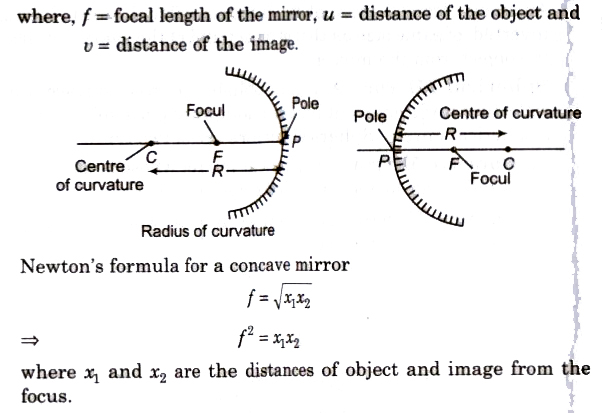
.
Linear Magnification
The ratio of height of image (1) formedby a mirror to the height of the object (O) is called linear magnification (m).
Lin ear magnification (m) = I/O = -v/u
Areal and Axial Magnification
The ratio of area of image to the area of object is called areal magnification.

Sign Convention for Spherical Mirrors
- All distances are measured from the pole of the mirror.
- Distances measured in the direction of incident light rays are taken as positive.
- Distances measured in opposite direction to the incident light rays are taken as negative.
- Distances measured above the principal axis are positive.
- Distances measured below the principal axis are negative.
Lateral lnversion
In the image formed by a plane mirror the right side of the object ppears as left side and vise-versa. This phenomena is called lateral inversion.
When object is placed between pole and focus of a concave mirror, then its virtual, erect and magnified image is formed.
A convex mirror forms a virtual, erect and diminished image for all conditions of object.
The focal length of concave mirror is taken negative and for a convex mirror taken as positive.
Refraction of Light
The deviation of light rays from its path when it travells from one transparent medium to another transparent medium, is called refraction of light.
The speed of light is different in different media. Laws of Refraction
(i) The incident ray, the refracted ray and the normal at the point of incidence, all three lies in the same plane.
(ii) The ratio of sine of angle of incidence to the sine of angle of refraction is constant for a pair of two media,

where 1&mu2 is called refractive index of second medium with respect to first medium.
This law is also called Snell’s law.
Refractive Index
The ratio of speed of light in vacuum (c) to the speed of light in any medium (u) is called refractive index of the medium.
Refractive index of a medium,
μ = c/v
Refractive index of water =4/3 = 1.33; Refractive index of glass = 3/2 = 1.50
When light is reflected by a denser medium, phase difference of π radian or path difference of λ/2 or time difference T/2 is produced. This is known as Stoke’s law. Distance x travelled by light in a medium of refractive index μ is equal to distance (&mux) travelled in vacuum.
Time taken by light to traverse a thickness x of time =μx/c, where c = velocity of light in vacuum.
Relative Refractive Index


The refractive index of second medium with respect to first medium
Cauchy’s Formula
Critical Angle
The angle of incidence in a denser medium for which the angle of refraction in rarer medium becomes 90°. is called critical angle (C).
Critical angle for diamond = 24°
Critical angle for glass = 42° :
Critical angle for water = 48° :
Refractive index of denser medium μ = 1/sin C

Total Internal Reflection (TIR)
When a light ray travelling from a denser medium towards a rarer medium is incident at the interface at an angle of incidence greater than critical angle, then
light rays reflected back in to the denser medium. This phenomena is called TIR.
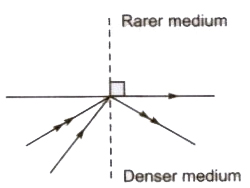
Critical angle increases with temperature.
The refractive index is maximum for violet colour of light and minimum for red colour of light. i.e., μv > μ R therefore critical angle is maximum for red colour of light and minimum for violet colour of light, i.e., Cv < CR
Total internal reflection occurs if angle of incidence in denser medium exceeds critical angle.
Mirage is an optical illusion observed in deserts and roads on a hot day when the air near the ground is holler and hence rarer than the air above.
Optical Fibres
are also based on the phenomenon of total internal reflection. Optical fibres consist of several thousands of very long fine quality fibres of glass or quartz. The diameter of each fibre is of the order of 10-4 cm with refractive index of material being of the order of 1.5. Optical fibres are used in transmission and reception of electrical signals by converting them first into light signals.
For Refraction at a Convex or Concave Spherical Surface

where, μ= refractive index, u = distance of object, v = distance of image and R = radius of curvature of the spherical surface
Lens
A lens is a uniform transparent medium bounded between two spherical or one spherical and one plane surface.
Convex Lens
A lens which is thinner at edges and thicker at middle is called a convex or converging lens.
Concave Lens
A lens which is thicker at edges and thinner at middle, is called a concave or diverging lens.
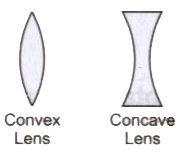
Lens Formula
1/f = 1/v – 1/u
where, f = focal length of the lens, U = distance of object, U = distance of image.
Lens Maker’s formula
1/f=(μ – 1) (1/R1 – 1/R2)
where, μ = refractive index of the material of the lens and R1 and R2 are radii of curvature of the lens.
Power of a Lens
The reciprocal of the focal length of a lens, when it is measured in metre, is called power of a lens.
Power of a lens, (P)= 1/f(metre)
Its unit is diopter (D).
The power of a convex (converging) lens is positive and for a concave (diverging) lens it is negative.
Focal Length of a Lens Combination
(i) When lenses are in contact 1/F – 1/f1 + 1/f2
Power of the combination P = P1 + P2
(ii) When lenses are separated by a distance d
1/F = 1/f1 + 1/f2 – d/f1f1
Power of the combination
P = P1 + P2 – dP1P2
Linear Magnification
m = I/O = v/u
For a small sized object placed linearly along the principal axis, its axial (longitudinal) magnification is given by
Axial magnification = – dv/du = (v/u)2
=(f/f+u)2 = (f-v/f)2
Focal Length of a Convex Lens by Displacement Method
Focal length of the convex lens f = (a2 – d2) / 4a
where, a = distance between the image pin and object pin and
d = distance between two positions of lens.
The distance between the two pins should be greater than four times the focal length of the convex lens, i.e., a > 4f.
Height of the object O = √I1I2
Cutting of a Lens
(i) If a symmetrical convex lens of focal length f is cut into two parts along its optic axis, then focal length of each part (a plano convex lens) is 2f. However, if the two parts are joined as shown in figure, the focal length of combination is again f.

(ii) If a symmetrical convex lens of focal length f is cut into two parts along the principal axis, then focal length of each part remains unchanged as f. If these two parts are joined with curved ends an one side, focal length of the combination is f/2. But on joining two 2 parts in opposite sense the net focal length becomes

Prism
Prism is uniform transparent medium bounded between two refracting surfaces, inclined at an angle.

Angle of Deviation
The angle sub tended between the direction of incident light ray and emergent light fay from a prism is called angle of deviation (δ).
Prism Formula
The refractive index of material of prism
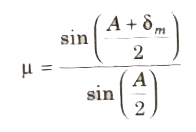
Dispersion of Light
The splitting of white light into its constituent colours in the sequence ofVIBGYOR, on passing through a prism. is called dispersion of light.
The refractive index μv > μR therefore violet colour deviates most and red colour deviates least. i.e., δv > δR.
Angular Dispersion
The angle suhtended between the direction of emergent violet and red rays of light from a prism is called angular dispersion.
Angular dispersion
(θ) δv – δR = (μv – μR A
where δv and δR are angle of deviation.
Dispersive Power
W = θ/δY = (μv – μ R) / (μY – 1)
where μY = (μ v + μ R ) / 2, is mean refractive index.
Human Eye
Human eye is an optical instrument which forms real image of the objects on retina.
Retina colours contains lakhs of cone and rod cells which of light and intensities of light respectively.

Ciliary muscles change the focal length of eye lens. This power of eye is called power of accomadation of eye.
Different defects of vision of human eye are described below
(i) Myopia or Short-Sightedness It is a defect of eye due to which a person can see near by objects clearly but cannot see far away objects clearly.
In this defect, the far point of eye shifts from infinity to a nearer distance.
This defect can be removed by using a concave lens of appropriate power.

(ii) Hypermetropia or Long-Sightedness In this defect, a person can see far away objects clearly but cannot see near by objects clearly.
In this defect the near point of eye shifts away from the eye.
This defect can be removed by using a convex lens of appropriate power.


(iii) Astigmatism In this defect, a person cannot focus on horizontal and vertical lines at the same distance at the same time.
This defect can be removed by using suitable cylindrical lenses.
(iv) Colour Blindness In this defect, distinguish between few colours. a person is unable to The reason of this defect is the absence few colours. of cone cells sensitive for
This defect cannot be removed.
(v) Cataract In this defect. an opaque white membrane is developed on cornea due to which person lost power of vision partially on completely.
This defect can be removed by removing this membrane through surgery.
Camera
A photograph camera consists of a light proof box, at one end of which a converging lens system is fitted. A light sensitive film is fixed at the other end of the box, opposite to the lens system. A real inverted image of the object is formed on the film by the lens system.
f-Number for a Camera: The f-number represent the size of the aperture.
f-number =Focal length of the lens (F) / Diameter of the lens(d)
Generally 2, 2.8, 4, 5.6, 8, 11, 22, 32 are f-numbers.
The amount of light (L) entering the camera is directly proportional to the area (A) of the aperture, i.e.,
L ∝A∝ d2
Brightness of Image ∝ (d2/f2)
where, d = dia meter of the lens and F = focal length of the lens.
Exposure time is the time for which light is incident of photographic film.
Simple Microscope
It is used for observing magnified images of objects. It is consists of a converging lens of small focal length.
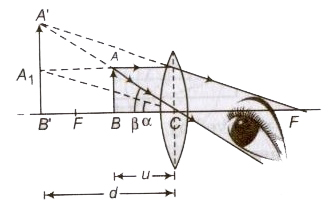
Magnifying Power
(i) When final image is formed at least distance of distinct vision (D), then M=1+d/f
where, f= focal length of the lens.
(ii) When final image is formed at infinity, then M = D/f
Compound Microscope
It is a combination of two convex lenses called objective lens and eye piece separated by a distance. Both lenses are of small focal lengths but fo < fe, where fo and fe are focal lengths of objective lens and eye piece respectively

Magnifying Power
M = vo / uo {1 + (D/fo)
Where vo= distance of image, formed by objective lens and
uo = distance of object from the objective
(ii) When final image is formed at infinity, then
M = vo/uo . D/fe
Astronomical Telescope
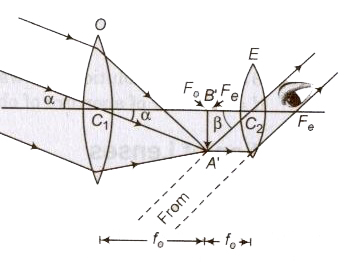
It is also a combination of two lenses, called objective lens and eye piece, separated by a distance. It is used for observing distinct images of heavenly bodies like stars, planets etc.
Magnifying Power
(i) When final image is formed at least distance of distinct vision (D), then M = fo/fe {1+ (D/fe)} where fo and fe are focal lengths of objective and eyepiece respectively.
Length of the telescope (L) = (fo + ue)
where, ue = distance of object from the eyepiece.
(ii) When final image is formed at infinity, then M = fo/fe
Length of the telescope (L) = fo + fe
For large magnifying power of a telescope fo should be large and fe should be small.
For large magnifying power of a microscope; fo < fe should be small.
Resolving Power
The ability of an optical instrument to produce separate and clear images of two near by objects, is called its resolving power.
Limit of Resolution
The minimum distance between two near by objects which can be just resolved by the instrument, is called its limit of resolution (d).
Resolving power of a microscope = 1/d = 2 μ sin θ / λ
where, d = limit of resolution, λ = wavelength of light used.
μ = refractive index of the medium between the objects and objective lens and θ = half of the cone angle.
Resolving power of a telescope = 1/dθ = d/1.22 λ
where, dθ = limit of resolution, A = wavelength of light used and
d = diameter of aperture of objective
Aberration of Lenses
The image formed by the lens suffer from following two rnaiIl drawbacks
(i) Spberical Aberration Aberration of the lens due to which the rays passes through the lens are not focussed at a single and the image of a point object placed on the axis is blurred. called spherical aberration.
It can be reduced by using
- lens of large focal lengths
- plano-convex lenses
- crossed lenses
- combining convex and concave lens
(ii) Chromatic Aberration Image of a white object formed by lens is usually coloured and blurred. This defect of the image produced by lens is called chromatic aberration.
Scattering of Light
When light passes through a medium in which particles are suspended whose size is of the order of wavelength of light, then light on striking these particles, deviated in different directions. These phenomena is called scattering of light.
According to the Lord Rayleigh, the intensity of scattered light
I ∝ 1/λ4
Therefore, red colour of light is scattered least and violet colour of light is scattered most.
Daily Life Examples of Scattering of Light
- Blue colour of sky.
- Red colour of signals of danger. /
- Black colour of sky in the absence of atmosp,here
- Red colour of the time of sun rise and sun set.
- The human eye is most sentitive to yellow colours. ## PREDICTION TUTORIALS ##



















Super blog . So help full
ReplyDeleteThank u
DeleteVery good beta 👌
ReplyDeleteThnk u
DeleteHey my friend share me your blog I just go through it and its fantastic
ReplyDeleteThnk u so much and pls follow our blog
DeleteThe video are too good and attractive although nice post
ReplyDeleteThnk u so much
DeleteToo good for board student good work God bless you
ReplyDeleteThnk u so much and our other blogs also for board students so pls follow our blogs
DeleteSuperubb blog one of the finest blog of prediction tutorial it will help students to understand well and clarify their topic .
ReplyDeleteWsh u good luck and keep rocking 👍🔥🔥
Thnk u so much
DeleteNice
ReplyDeleteThank u
DeleteGreat job
ReplyDeleteThnk u
DeleteNice presentation...
ReplyDeleteThnk u so much
DeleteHi prediction tutorials this is one of the best post and you Nice used of words & images(examples) in this article. Keep doing 👍
ReplyDeleteThnk u sumit
DeleteSo easy explanation 👌👌👌
ReplyDeleteThnk u
DeleteEste é um blog incrível, estou surpreso que a maneira como você explicou é fantástica
ReplyDeleteI'm so glad you liked our blog thank u so much and keep supporting to us
DeleteHi I am Priya madam/sir Apne carbon wala half post kiya tha mujhe uske notes chahiye
ReplyDeleteHlo priya carbon wala post Pura dal diya h aap hmara previous post check kre carbon and it's compound( part 2)
DeleteGood work Bro blog bhi start kar diye or youtube sab kuch akele hi kar raha hai kiya . All rounder hai
ReplyDeleteThnk u bs Aapki kripa se sb chlra h
DeleteBro kirapa to humpe karde
DeleteFantastic 👍👍such a good explanation 👍 keep it up diduu 👌👌
ReplyDeleteThnk u bacha
Delete